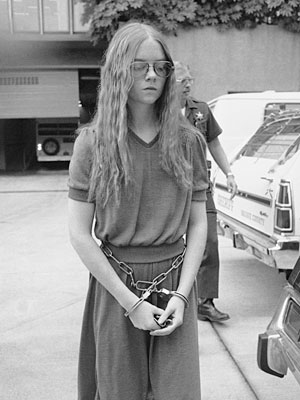“Ugh, it’s Monday” are the words that usually follow the arrival of the most dreaded day of the week. The sighs floating in the air are palpable and nothing seems possible. Mondays always carry with them a negative connotation and contain components such as depression, fatigue, and anguish. But to a San Diego elementary school, and to a troubled sixteen year old, Monday, January 29, 1979 held an even more distressing meaning.

Students at Grover Cleveland Elementary School, located in San Diego, California, began what they believed would be a normal Monday morning like any other, with bells ringing and students racing to their classes. Little did they know, however, that across the street, sixteen-year-old Brenda Ann Spencer was aiming her .22 caliber semiautomatic rifle right at society’s ultimate refuge, the elementary school, and its surroundings. After the first bell rang, Brenda broke the panels on the front door of her home, which was located right across the street from the elementary school. And she began to fire. The school’s principal, Burton Wragg, while rushing outside, was hit on the shoulder and chest with Spencer’s bullets and eventually died. Michael Suchar, the school’s custodian, ran outside with a blanket in order to cover Wragg and keep him from going into shock, but he quickly became the second victim of Spencer’s shooting and lost his life. In between all the chaos, 28 year old Robert Robb, a recent graduate of the police academy, while examining Wragg’s and Suchar’s bodies, was shot under his right shoulder blade.1 He would go on to survive though, along with the eight other children who were wounded in the incident. At least three of those children had abdominal wounds. A nine-year-old student, Cam Miller, was struck in the back with a bullet that exited through his chest without hitting any internal organs. Another, Christy Buell, was shot through her abdomen and in the buttocks, and had to undergo surgery in order to repair her intestine.2
When Gus Stevens, a reporter for the San Diego Evening Tribune, began calling around the area to gain more information about the shooting, he coincidentally placed a call to Spencer’s home where she gave him exactly what he wanted. She described the shooter, a sixteen year old, and the shooter’s address. When Stevens realized that she gave him her own address, he recognized what was going on and requested an interview while another staff member informed the police of the situation. The police, now aware of where the shots were coming from, were able evacuate the children and obstruct Spencer’s line of sight while trying to negotiate with her. After several hours, Brenda Spencer surrendered her weapon and several rounds of ammunition, and was subsequently arrested. While on the phone with Stevens, Spencer had stated that she was just shooting for the “fun of it.” She went on to say that she just didn’t like Mondays and did this “because it’s a way to cheer up the day.”3

Contrary to her initial claim, she later went on to state in her 2001 parole hearing that she had been “sexually abused by [her] father” and was “waiting for the cops to show up so they could shoot [her].”4 This new information has fueled many more theories today about Brenda Spencer’s true motives in committing such a crime. During her pretrial psychological testing, an injury to Spencer’s temporal lobe came to light. Spencer has also stated in a letter from prison that she experiences “grand mal seizures” that she has to counteract with medications.5 Such a brain injury would definitely be a precursor to epilepsy, which is two to four times more common among violent offenders than the public.6 The lack of treatment she received for this disease, to some, proves the neglect that she experienced from her family and in her childhood. Psychologist Jonathan Fast introduces the idea that her brain injury, abuse, and the effects of it pushed her to her final actions. He believes that the shame, ridicule, inferiority, and powerlessness that she felt encouraged her to go as far as she did. In another letter she wrote in prison, she stated that her “father had done everything a person could do to another person. The beatings, the touching, the emotional abuse.” She went on to state that no one, not teachers or counselors, gave her assistance through this, so she simply thought that this was how the world and how life worked. When her father gifted her the .22 caliber rifle, she thought that he was finally telling her to do it: to take her life successfully, unlike her past suicide attempts, and leave the world forever.7
Whether these theories are true or not, Brenda Spencer was tried as an adult and pleaded guilty to two counts of murder and nine counts of assault. She was sentenced to twenty-five years to life in prison, and is still serving her sentence at the California Institute for Women. The shooting has inspired a song by the Boomtown Rats called “I Don’t Like Mondays,” and has also gained other media coverage through a documentary.8 Her action went down in history as the first high profile school shooting and has become a vanguard to many future, unimaginable school situations and violent outbreaks. Whether Spencer was a cold-hearted killer or a truly lost and confused soul that simply wanted an escape, it is undeniable that her horrible actions have had some frightening consequences in our modern world.
- Jonathan Fast, Ceremonial Violence (New York: The Overlook Press, 2008), 25, 70-71. ↵
- Tamara Jones, “Look Back in Sorrow,” Good Housekeeping 227, no.5 (November 1998): 118. ↵
- Jonathan Fast, “Unforgiven and Alone: Brenda Spencer and Secret Shame,” in School Shootings: International Research, Case Studies, And Concepts For Prevention, ed. Nils Böckler (New York: Springer, 2013), 253-255. ↵
- Debra Sevey, “Subsequent Parole Consideration Hearing of Brenda Spencer,” (Capitol Electronic Reporting, 2001), 15-16. ↵
- Jennifer Furio, Letters From Prison: Voices Of Women Murderers (New York: Algora Pub., 2001), 134. ↵
- Jonathan Fast, ” Unforgiven and Alone: Brenda Spencer and Secret Shame,” in School Shootings: International Research, Case Studies, And Concepts For Prevention, ed. Nils Böckler (New York: Springer, 2013), 251. ↵
- Jennifer Furio, Letters From Prison: Voices Of Women Murderers (New York: Algora Pub., 2001), 134-135. ↵
- Encyclopedia of School Crime and Violence, September 2011, s.v. “Brenda Spencer,” by Laura L. Finley. ↵



243 comments
Vanessa Sanchez
School shootings are something horrific that sadly has been happening often. I had never heard of this school shooting in particular. Its just ridiculous how someone puts kids life in danger just because of the simply fact that they hate Mondays. I understand where she’s coming from. In reality she was traumatize she could have found this as an exit to the pain she has been holding. But never it is right to put innocent life’s in risk. Never take the anger into taking the actions in your own hands. I understand she saw there was no one who can hear her. I don’t know what she could possibly do but point is that a kids life should never be a target.
Diamond Davidson
I don’t think I ever heard of this school shooting until now. This sixteen year old was really out of her mind for this, she didn’t have a true meaning for why she shoot to injure and/or kill people. Because “she didn’t like Monday” that’s the dumbest excuse I have ever heard. School shootings are the most unexpected and a terrifying moment to experience especially as a child. I remember being at school scared for my life wondering if we were going to have a school shooting one day, it’s scary to think that because we will never know when it will happen. It’s so much to take in.
Kyra Dantzle
She did it because she wanted to commit suicide. She had tried but(obviously) failed to do so before. So she figured that she would shoot at the school, the police would kill her but she surrendered.She didnt intend to kill anyone(not trying to validate what she did)but she just had good shooting skills.
Danniella Villarreal
She had reports of sexual abuse and other problems are terrible but to take her anger out on elementary students is inexcusable. she hurt many people and killed a couple. I do feel bad for her because of everything she went through, like her lesioned temporal lobe that was not medically treated. Even if she had problems that normally led to violent acts this type of action was not the answer, even if she wanted the cops to shoot her in the end. Very nice article to read.
Lilliana Canales
Her reports of sexual assault and emotional abuse don’t add up as to why she would target an elementary school. Women of this abusive background tend to either go after their perpetrator or all men, this child clearly had something wrong with her if she thought trying to kill little kids was going to cheer up her day because it might be fun. I feel terrible that she was never counseled through her traumatizing experience, but I don’t feel sorry for her incarceration and yes it was a “mistake”, if you will, committed by a teenager and people change, but again, there was something seriously wrong with her and if she gets released, I hope they find her psychiatric help because she’s going to need it.
Honoka Sasahara
I think that she was not a cold-hearted person but just a normal girl who grew up in extremely terrible condition. I believe experiences in youth can effect one’s character and future in a high degree. The accident was a tragedy itself, but it might be prevented by people around her when she was young by saving her from such a awful things she had gone through.
Emma
I am very surprised that the localization of her brain injury hasn’t been more detailed and investigated. Indeed, a lesioned temporal lobe can be linked to a fronto-temporal dysconnexion. This type of lesion creates a sort of gap between anticipation/organization behaviors and emotional centers. In some ways, this can lead to violent behaviors, and hence explain this type of break downs. I wonder if it has been investigated again today with new brain investigation techniques, but it would be very interesting.
Cynthia Rodriguez
Several mass shootings, especially school shootings, have occurred much more frequently in the past few years. I personally do not know much about shootings that happened in other decades, but I like that this article talked about the first high school shooting. Whenever I hear about shootings, I always ask myself “Why? Why would anyone ever do such a thing?” It makes me sad that several people lost their lives that Monday, and when I read that Spencer initially said she did it just for fun, it upset me. As I read on, however, it made me realize that there was more to her story. I’m not too sure if the theories are true, but I do believe that maybe her past experiences did play a big role in what she did that Monday and that it wasn’t just for fun. Maybe it was just bottled up anger and emotions. Whatever the reason, what she did was wrong and I think it is just that she is serving her time. This article was very nicely written. It was descriptive and engaging. Great job!
Cooper Dubrule
In a society where mass shootings happen on a regular basis, this case still stands out for the simple reason that it was committed on an elementary school. To evaluate the reasons for the mass murder is a lot harder because it really can’t be out of personal hatred. You rarely hear about happenings like this in the 70’s and 80’s and it is very hard to keep people from advancing to the state of being a mass murderer even with today’s technology and research.
Mariah Garcia
This article brings to mind the concept of suicide by cop, which seems to be an apparent motive for the actions carried out by Spencer. Just as well, the apparent abuse suffered by Spencer, though it does not justify her actions, explains why she did what she did, as explained eloquently within the article. These aspects combined with the violent nature of the crime makes me think that maybe this individual had some sort of underlying mental health issue, which I did not see mentioned in this article.
Adam Portillo
This article was very sad and disturbing to me. The crime that Brenda Spencer committed was truly horrific and terrible. It was an act of evil especially as she shot down those kids at the elementary school. I feel that Brenda Spencer did this because she was trying to say something and wanted attention to what she was trying to tell us. I feel that Spencer’s traumatic experiences led to her doing this. Great article.